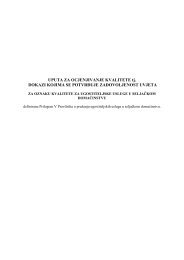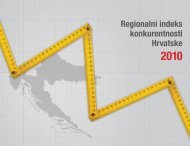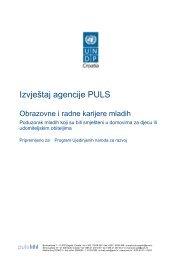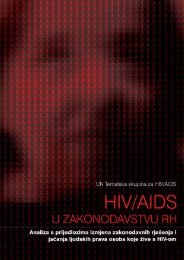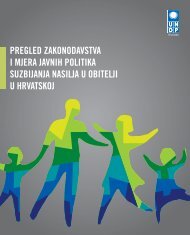WEB engleska verzija end.indd - UNDP Croatia
WEB engleska verzija end.indd - UNDP Croatia
WEB engleska verzija end.indd - UNDP Croatia
- No tags were found...
Create successful ePaper yourself
Turn your PDF publications into a flip-book with our unique Google optimized e-Paper software.
CHAPTER 3THE SOCIALLY EXCLUDED134the case with institutionalised children. To preventsocial exclusion and support a sound development,a balance is needed between targeted support andmainstreaming that fosters the inclusion of thesechildren in their peer group. The Ombudsman’s Officefor Children also advocated for periodic assessmentsof the reasons and justifications for a child’s stay in aninstitution, as well as for priority support for familieswith children in institutions, with the purpose ofstrengthening ties and re-establishing a quality relationshipwith these children.Preventive community-based social services thatsupport children and their families according totheir specific needs are still rare in <strong>Croatia</strong>. The stateonly intervenes when family problems escalate, forexample when children become victims of neglect orabuse, and/or develop behavioural problems. Manychildren are then separated from their families andplaced in institutions. On average children stay forfour years in institutions but many of them stay untilthey leave secondary school or reach adulthood. Spatialand material conditions in children’s institutionsare often inadequate and in more than half of allhomes five or more children share a room. In recentyears attempts were made to place older children inprotective apartments so they could further developtheir life skills. However, this has not led to a reductionin institutionalisation as these children wereimmediately replaced by others entering institutionalcare (Bošjnak et al. 2002).Institutionalisation is unlikely to give children thesupport they need in terms of counselling, educationand the development of life skills. The Committee onthe Rights of the Child, for example, expressed specificconcerns about violence in care institutions in <strong>Croatia</strong>(Cantwell et al. 2005). This may lead to the paradoxicalsituation that children who are victims of abuse areplaced in institutions that may be abusive themselvesand use corporal punishment and emotional cruelty(Bošjnak et al. 2002). Hence, in developing new services,priority needs to be given to supporting thechild within the family for as long as possible. In this,social workers from different services, such as childcarefacilities, schools, health services and the policeshould form strong local partnerships and coordinatetheir work to be better able to help families. It is alsocrucial that children and their families are heard in theprocess and that they are seen as partners in creatingtheir own solutions.3.17 Common Issues and Concernsfor Socially Excluded GroupsThree things stand out from the examination of groupsat risk of poverty and social exclusion. The first is thelack of sufficient in-depth data and research whichfor most of the identified groups significantly inhibitsthe development of appropriate policies. <strong>UNDP</strong>research on the Quality of Life and the qualitativeresearch on focus groups have made a step forwardin this respect. Secondly, the analysis shows that theincrease of the social inclusion of each disadvantagedgroup requires a multi-dimensional and holistic approachthat cuts across a broad range of policy areas.The third point is the extent to which the differentgroups share common issues and common areas forimprovement. Thus, what is required is to increasethe access to essential services while at the same timetailoring those services to specific needs and adaptingthem to the specific situations of the vulnerable.Some of the common issues and common strands arehighlighted below.Human rights and anti-discrimination: A key issuethat emerges for several groups is the need tostrengthen the enforcement of anti-discriminationlegislation. This is particularly evident in relation tothe Roma, returnees and people with physical andintellectual disabilities. However, it is also relevantto people with HIV, sexual minorities, people living ininstitutions, the homeless, prisoners, single parents,victims of domestic violence, and children. The issuegoes beyond simply enforcing legislation. It alsoinvolves ensuring the right to fully participate insociety, combating marginalisation, and to having avoice in the decision-making processes. This involvesraising awareness about human rights and promotingthe empowerment of groups.Access to social security: The issue of improving thesocial security system in order to ensure an adequatebasic income emerges for several groups. It is particularlystressed in relation to people with physical disabilities,single parents, the long-term unemployedand some pensioners, especially those living alone.Another common issue is the need to link socialsecurity payments more closely to personal plansand social supports, which will motivate people andincrease their ability either to access employment or



